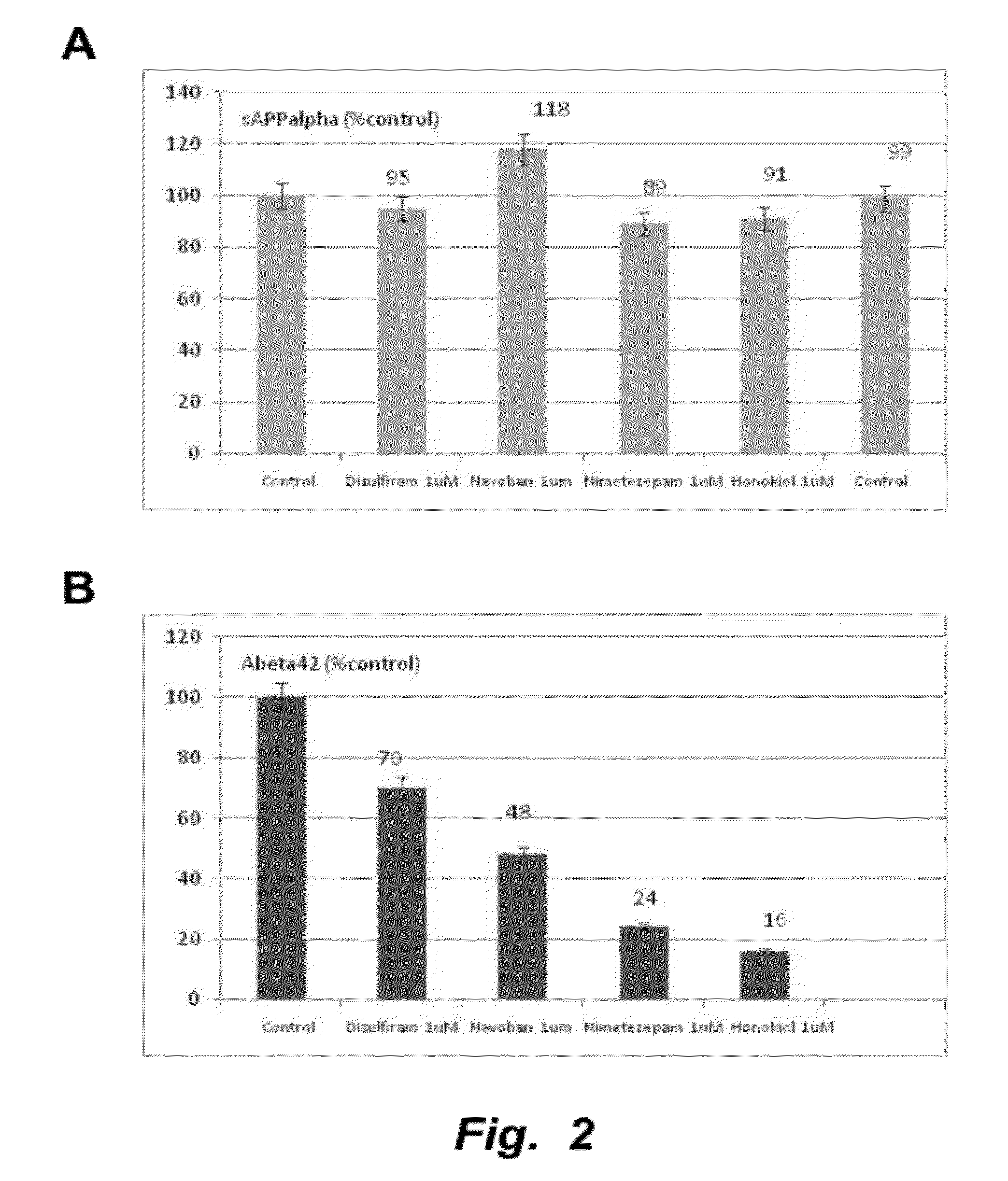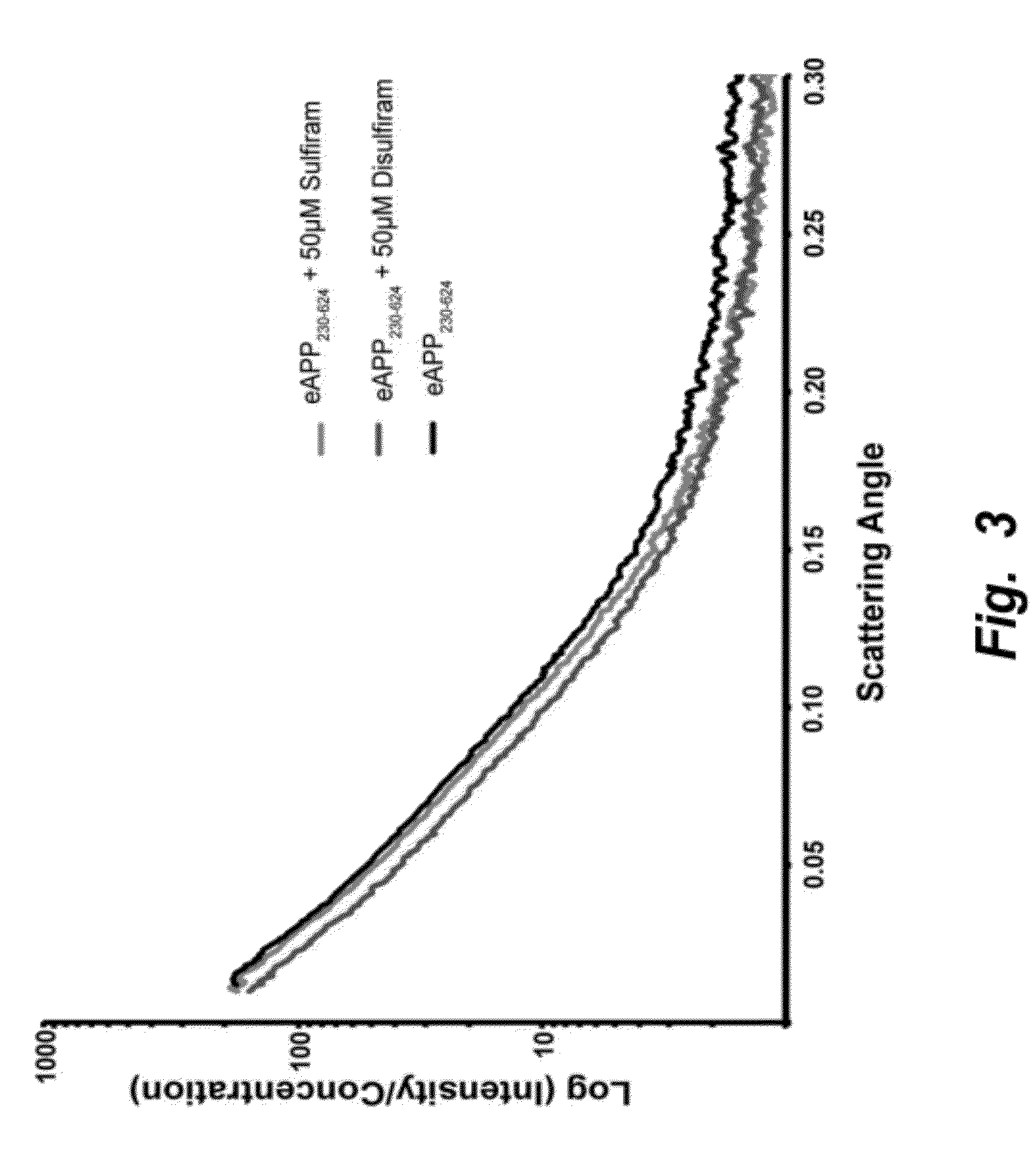Methods of treating mild cognitive impairment (MCI) and related disorders
a cognitive impairment and related disorder technology, applied in the field of progressive neurodegenerative disorders, can solve the problems of not offering a physiological role for the peptide, limited to no cognitive improvement,
- Summary
- Abstract
- Description
- Claims
- Application Information
AI Technical Summary
Benefits of technology
Problems solved by technology
Method used
Image
Examples
example 1
ALPHALISA® Assays in 7 W APP Transfected Cells
[0147]This example provides experimental methods for measurement sAPPα, Aβ42 and APPneo
[0148]In vitro compound testing assay: 7 W CHO cells were seeded at 50,000 cells / well in a 96 wells plate for 24 h. Then their medium was changed for fresh medium supplemented with 1 μM compounds (e.g., tropisetron, disulfuram, honokiol, and / or nimetazepam). After 24 h, 20 μl of the medium was added to 2 μl of the complete protease inhibitor with 1 μM EDTA and kept at 4° C. until analysis. 2 μl of that medium was treated with the Perkin Elmer (PE) ALPHALISA® Aβ kit to determine the amount of Aβ42 secreted by the cells in 24 h using the PE-Enspire reader. Another aliquot of 2 μl of the medium was diluted with 50 μl of the PE ALPHALISA® buffer and was treated with the PE ALPHALISA® sAPPα kit to determine the amount of sAPPα secreted by the cells in 24 h. For the assay, 2 μl of the final mixture was treated with the acceptor bead and the donor antibody fo...
example 2
J20 (PDAPP Mouse Model) Primary Neuronal Cells
[0149]This example provides experimental methods for measurement of sAPPalpha, Aβ42 and APPneo in primary neuronal cells.
[0150]In vitro primary culture compound testing assay: Primary neuronal cultures were made from embryonic 18 day mice J20 hippocampi. The embryos were produced by breeding J20 male and J20 female (both heterozygous)—this gives a 50-75% transgenic culture. Cells were mixed from all embryos and plated at 2×105 in 6 or more wells (depending on the number of embryos) of a 48 well culture plate previously coated with Poly-L-lysine. Cells were allowed to attach overnight and the compounds (e.g., tropisetron, disulfuram, honokiol, and / or nimetazepam) were added 24 hours after the culture was made. Three wells were used for each compound and a vehicle-only control is always run. The compounds were added to the cells every day for 3 days; on the third day media was collected, protease inhibitors added and the media stored. Afte...
example 3
Mouse Brain Uptake and Biomarker Studies
[0151]This example provides experimental methods for in vivo measurement of compound brain penetration and effect on sAPPalpha, Aβ40 / 42, and APPneo in the PDAPP mouse model.
Methods
[0152]ALPHALISA Analysis: ALPHALISA® kits from Perkin Elmer (PE) were used to quantify sAPPα (cat#: AL254C), sAPPβ (cat#: AL232C), Aβ40 (cat #: AL275C), Aβ42 (cat #: AL276C) and Tau (cat#: AL271C) from brain homogenates. The samples are added to an AlphaPlate-384 (cat#: 6005350). Twenty microliters (μl) of acceptor bead antibody mix was added to each five μl cerebrospinal fluid (CSF) sample and allowed to incubate for one hour at room temperature. Next, 25 μl of donor beads were added and allowed to incubate in the dark for 30 minutes at room temperature. Fluorescence was then measured on an EnsPire 96-well plate reader (Perkin-Elmer).
[0153]ELISA assays: ELISA kits from Invitrogen were also used to quantify Aβ1-40 (KHB3481) and Aβ1-42 (KHB3544) in duplicate from the ...
PUM
| Property | Measurement | Unit |
|---|---|---|
| Time | aaaaa | aaaaa |
| Time | aaaaa | aaaaa |
Abstract
Description
Claims
Application Information
 Login to View More
Login to View More - R&D
- Intellectual Property
- Life Sciences
- Materials
- Tech Scout
- Unparalleled Data Quality
- Higher Quality Content
- 60% Fewer Hallucinations
Browse by: Latest US Patents, China's latest patents, Technical Efficacy Thesaurus, Application Domain, Technology Topic, Popular Technical Reports.
© 2025 PatSnap. All rights reserved.Legal|Privacy policy|Modern Slavery Act Transparency Statement|Sitemap|About US| Contact US: help@patsnap.com



